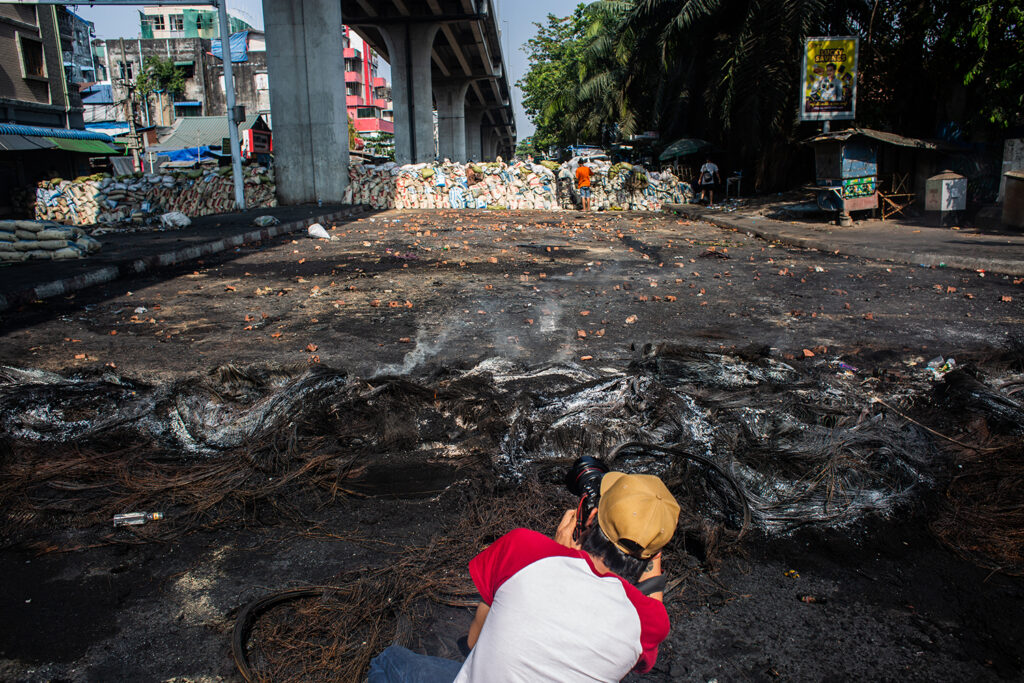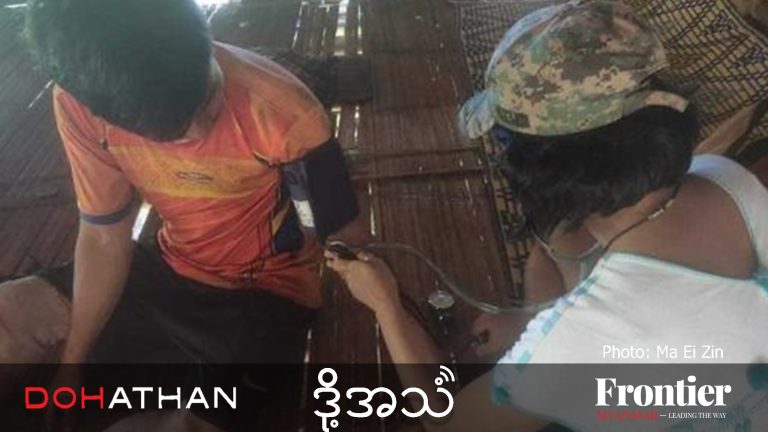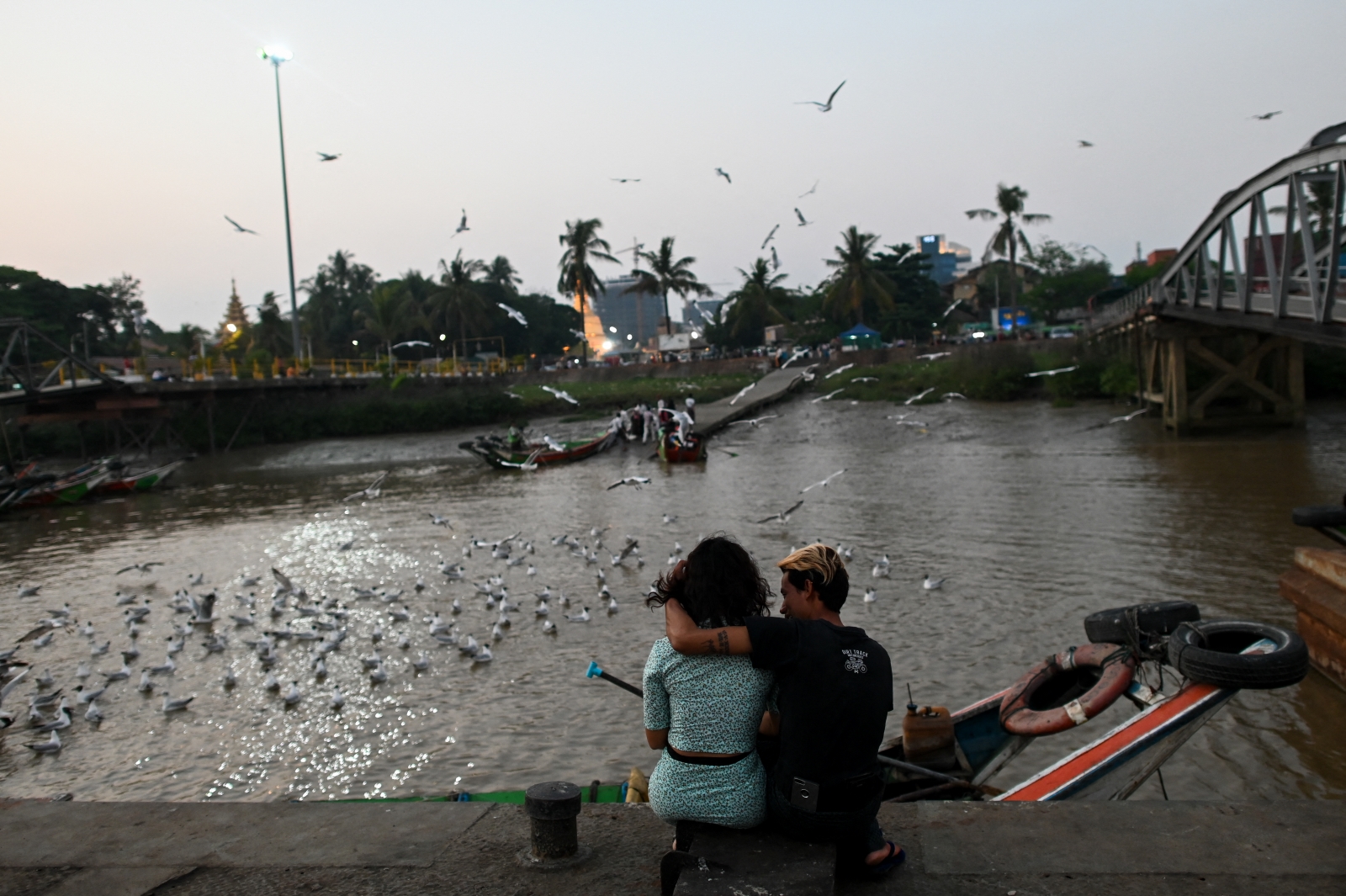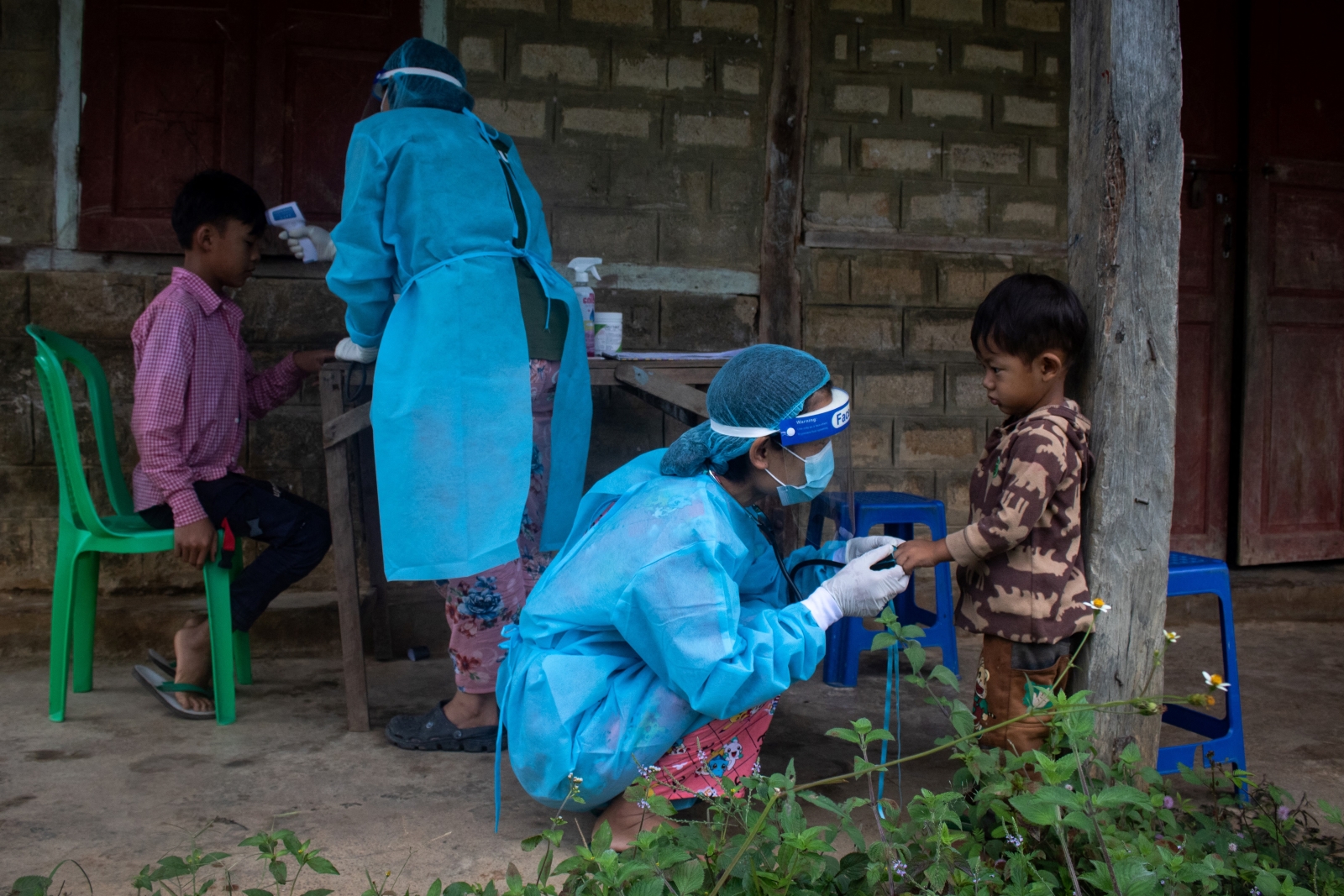Freelance photojournalists have been putting their lives on the line to cover Myanmar’s post-coup conflict, but many are struggling to place their photos and make ends meet.
By FRONTIER
When Ko Myo Satt Hla Thaw heard a plane fly overhead, he sprinted to a bunker with his precious camera and waited until he could come out to take pictures of whatever grim scene might confront him.
It was the night of June 13 in Kayah State’s Mese Township. The resistance had attacked three military outposts earlier that day and the Tatmadaw had responded with indiscriminate airstrikes. When Myo Satt Hla Thaw emerged from his refuge he witnessed a scene of utter destruction.
“In the morning, the landscape was littered with rubble as far as the eye could see,” he said.
The February 2021 coup sparked widespread protests, which were met with brutal military crackdowns. This in turn gave way to armed uprisings in many parts of the country, including in Kayah State. But as the regime has lost ground to anti-coup forces and their ethnic armed group allies, it has increasingly relied on airstrikes to pummel its opponents.
Before the coup threw the country into turmoil, the preceding decade of democratic reforms saw a blossoming of Myanmar independent media. Myo Satt Hla Thaw was a photojournalist with Myanmar Now, an outlet respected for the high quality of its journalism.
“At the beginning of the Spring Revolution, I took photos of protests for Myanmar Now,” he said. “On February 28, 2021, I was standing nearby when a young man was killed by live ammunition near Hledan intersection in Yangon’s Kamaryut Township and was able to take a photo.”
Myo Satt Hla Thaw’s images of that young man, whose name was Ko Nyi Nyi Aung Htet Naing, was used by the outlet and made available to publications around the world.
“The advantage of photography is that it shows the facts. One photo can express a lot,” he said.

Staying on the ground
But Myanmar Now was one of many independent media organisations ordered to shut down by a junta with no tolerance for dissent, and it had to go into exile in order to continue its coverage.
Myo Satt Hla Thaw had the option to join his colleagues abroad, but decided to stay.
“I chose to continue taking photos because I wanted to work on the ground in Myanmar. So I quit my job and became a freelance photojournalist,” he explained.
Photojournalist Ko Mar Naw was also previously based in Yangon, but was one of more than a dozen staff members to resign from Myanmar Times in protest less than three weeks after the coup. Management had ordered a reporter to cover a junta press conference that the newsroom had decided to boycott.
He continued covering the deteriorating situation in Yangon until September 2021, when he decided to travel to Myanmar’s conflict zones to better document the armed uprisings.
“If you are a photojournalist you have to be close to the action,” Mar Naw told Frontier.
He first visited territory controlled by the Ta’ang National Liberation Army, an ethnic armed organisation that was helping to train some of the People’s Defence Forces formed after the coup. In December that year, he travelled to Sagaing Region, the site of the fiercest fighting between PDFs and the military, before making his way to Kayah in July last year.
While Mar Naw and Myo Satt Hlaw Thaw have embedded with armed groups, other photographers have further blurred the lines between journalism and resistance.
Ko Kyaw* was let go from the outlet that was employing him after the coup and joined a PDF battalion in the Karen National Union’s Brigade 6 area, which covers Kayin State’s Kawkareik Township.
“After my job was suspended, I wanted to continue shooting photos as a freelance photojournalist, but I also had a strong desire to participate in the revolution. So I decided to serve in a PDF and document what was happening as best as I could. The images I take will form part of an important historical record in the future,” he said.
For Mar Naw and others, photography is a labour of love, done out of a sense of duty.
“Ever since I began working as a freelance photojournalist, my first objective was just to take news photos. I didn’t think about where to sell the images, or display them, or if I could make money from them,” he said. “If I can’t find stories in Yangon, I will find a way to go to places where I can continue to take photos.”

Struggling to make ends meet
But while photographers might not expect to strike it rich working in journalism, increasingly they say they are unable to support themselves at all.
“Since I started working as a freelance photojournalist, I’ve had to pay for everything myself, from travel costs to living expenses,” said Myo Satt Hla Thaw.
“Some photojournalists even have to work other jobs to earn enough income to cover their expenses.”
Mar Naw said this job is unsustainable, and doesn’t know how long he can keep it up.
“We are experiencing the great historical event of the Spring Revolution and it’s important to record what is happening and what people are enduring, but anyone who wants to continue working as a photojournalist is struggling. Nobody is paying photojournalists for their work,” he said. “I think the time will come when I can no longer continue to be a photojournalist.”
Myanmar’s local news outlets are also struggling financially, and feel they can’t necessarily take responsibility for the huge amount of risk involved in traveling to conflict zones.
“News outlets are unable to take responsibility for the safety and cost of using photojournalists, so many have become unemployed. In many local news outlets, there are almost no permanently employed photojournalists,” Mar Naw said.
J Paing, editor-in-chief of the Myanmar Pressphoto Agency, acknowledged that he used to employ seven photographers but now only has three.
“The main problem is that we at MPA can’t provide full support to photojournalists when they go on the ground due to our financial difficulties,” he said.
Mar Naw said increasingly, local outlets are relying on photos taken by non-professionals, like citizen journalists, who don’t charge for their images.
“Pictures from local people are sometimes needed, when they are in places where there are no photojournalists. But many local news outlets now ignore the pictures taken by photojournalists,” he said.
Even photojournalists with permanent employment can face difficulties. Ko Kaung Zaw Hein, a photojournalist with MPA, said due to the outlet’s financial instability, his salary is sometimes delayed or paid gradually.
“When I went to the frontlines to take photos, which I did recently in the Karenni region, the agency couldn’t fully cover my expenses for an extended period. In such circumstances, I have to ask for help from friends, my parents and other relatives,” he said.
Kaung Zaw Hein said he’s also seen an increase in outlets relying on citizen journalists, or simply lifting photos from the Facebook pages of resistance groups.

Worth the risk?
Financial difficulties aren’t the only challenges facing photojournalists, who must also work in rugged and dangerous conditions.
In Kayah, Myo Satt Hla Thaw said travel is extremely difficult and so is accessing electricity to charge his camera batteries or upload photos.
“Because these are frontline areas, there are no buses to go from one place to another like in a city. If you can’t afford to rent a car, you can use a motorcycle to save money, but if it rains, cameras can be damaged while riding a motorbike,” he said.
Despite the practical difficulties, Myo Satt Hla Thaw has been able to take pictures that expose the military’s human rights violations in Kayah. “I was able to capture images of religious buildings being burned and military council troops targeting hospitals and schools,” he said.
“When I send my photos to the Myanmar local media and see them published, my stress is relieved,” he added. “We risk our lives to take photos on the ground, so media outlets should recognise our work and use the pictures we take.”
Kaung Zaw Hein echoed his colleague.
“I recommend that news outlets contact photojournalists who are on the ground and use their images. In the midst of what is happening we need to acknowledge the importance of news and photographs to provide a record,” he said.
At least four journalists have been killed by the military since the 2021 coup, including two photographers who were allegedly abducted and killed in custody, both of whom had documented peaceful protests against military rule.
“The images taken by photojournalists risking their lives deserve to be bought by media outlets and I appeal to them not to ignore the work we do,” Mar Naw said.
* indicates a pseudonym for security reasons







